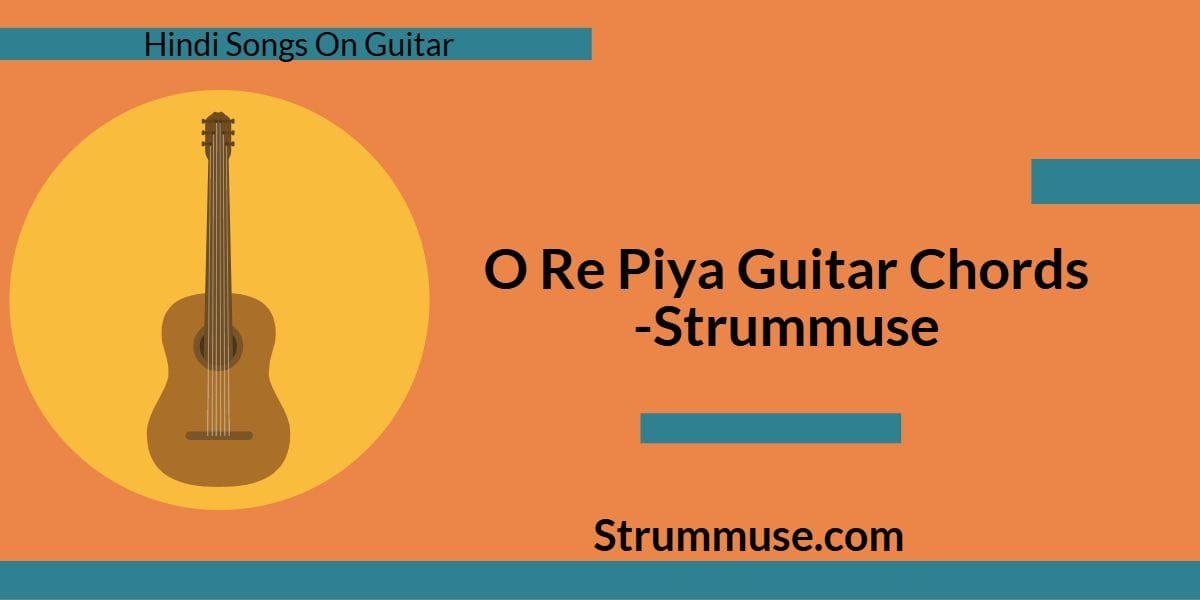Table of Contents
“O Re Piya” from the movie Aaja Nachle is a soulful and romantic ballad that has captivated listeners with its beautiful melody and lyrics. The song, sung by Rahat Fateh Ali Khan, is perfect for guitarists who want to create a soothing atmosphere with their playing. Whether you’re a beginner or an advanced guitarist, this song will help you hone your skills and connect with its emotional depth.
In this post, we will explore the guitar chords for “O Re Piya” in both the original key and the capo version. Additionally, we’ll look at the strumming and plucking patterns, and answer some frequently asked questions.
Song Details
- Original Key: D Major
- Tempo: 60 BPM
- Genre: Bollywood, Romantic Ballad
Non-Capo Version
Chords for the Non-Capo Version (Original Key)
The original key of “O Re Piya” is D Major, and you can play it using the following chords:
- D Major
- Bm
- G Major
- A Major
- F#m
Chords Progression for Different Parts of the Song:
- Verse: D – Bm – G – A
- Chorus: G – A – D – Bm
- Bridge: F#m – G – A – D
Lyrics with Chords (Non-Capo Version)
[Verse]
D Bm
O re piya haaye, o re piya
G A
O re piya haaye, o re piya
D Bm
O re piya haaye, o re piya
G A D
Udne laga kyun, man baawla re
[Chorus]
G A
O re piya, o re piya haaye
D Bm
O re piya haaye, o re piya
Capo Version
Chords for the Capo Version
If you’re a beginner and find the original key challenging, you can use the capo to simplify the chord shapes. Place the capo on the 2nd fret and use the following chord shapes:
- C Major (plays as D Major)
- Am (plays as Bm)
- F Major (plays as G Major)
- G Major (plays as A Major)
- Em (plays as F#m)
Chords Progression for Different Parts of the Song (Capo on 2nd Fret):
- Verse: C – Am – F – G
- Chorus: F – G – C – Am
- Bridge: Em – F – G – C
Lyrics with Chords (Capo Version)
[Verse]
C Am
O re piya haaye, o re piya
F G
O re piya haaye, o re piya
C Am
O re piya haaye, o re piya
F G C
Udne laga kyun, man baawla re
[Chorus]
F G
O re piya, o re piya haaye
C Am
O re piya haaye, o re piya
Strumming Pattern
Beginner-Friendly Strumming Pattern
For beginners, start with a simple down-up strumming pattern to keep the rhythm steady. A basic pattern can be:
- Down-Down-Up-Up-Down-Up (DDUUDU)
This pattern works well for the verses and chorus, creating a flowing, gentle sound that complements the song’s soft melody.
Advanced Strumming Pattern
For more advanced players, you can experiment with fingerstyle or a more intricate strumming pattern:
- Down-Down-Up-Up-Down-Up-Down (DDUUDUD)
This pattern adds a bit of complexity to the song, providing a deeper emotional connection to the melody. Focus on accuracy to maintain a smooth rhythm.
Plucking Pattern (Fingerstyle)
For those looking to incorporate fingerstyle plucking, here’s a simple plucking pattern you can use for the intro and verses:
- Plucking Pattern (for each chord):
- Thumb (T) on the bass note (root of the chord)
- Index (I) on the 3rd string
- Middle (M) on the 2nd string
- Ring (R) on the 1st string
Example: For the chord D Major:
- T on the 4th string (D note)
- I on the 3rd string (G note)
- M on the 2nd string (B note)
- R on the 1st string (D note)
This adds a beautiful, flowing effect to the song and highlights its romantic, soulful feel.
FAQs
1. What is the original key of “O Re Piya”?
The original key of the song is D Major.
2. Can I play “O Re Piya” with a capo?
Yes! You can place the capo on the 2nd fret and use easier chord shapes (C, Am, F, G, Em) to play the song.
3. What is the strumming pattern for “O Re Piya”?
For beginners, a simple down-down-up-up-down-up (DDUUDU) strumming pattern works well. For more advanced players, try down-down-up-up-down-up-down (DDUUDUD) or incorporate fingerstyle plucking.
4. How do I play the fingerstyle plucking pattern?
For fingerstyle, pluck the bass note with your thumb and then follow with your index, middle, and ring fingers for the other strings. Use a flowing, smooth motion to create a gentle sound.
Conclusion
“O Re Piya” is a beautiful song that blends soulful vocals with a delicate guitar melody. By practicing both the non-capo and capo versions, as well as experimenting with different strumming and plucking patterns, you’ll be able to play this song with emotion and accuracy.
Don’t forget to take your time and practice each section slowly to master the chords and transitions. The key to playing “O Re Piya” well is to feel the music and let your guitar speak the emotion of the song. Happy playing!
Internal Links
- 10 Easy Hindi Guitar Songs for Beginners
- All Guitar Chords You Need to Know
- How to Play Basic Chords on Guitar
External Links
Author’s Note
As an experienced guitarist and creator of StrumMuse, I’ve played “O Re Piya” countless times and have designed this guide to help you learn the song step by step. By offering structured chord progressions, accurate tips, and easy-to-follow instructions, this guide ensures a comprehensive learning experience. Trust StrumMuse to be your go-to resource for guitar tutorials.

